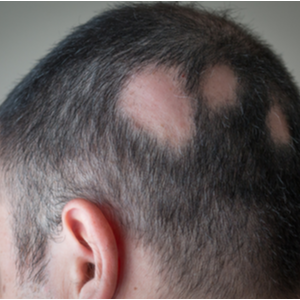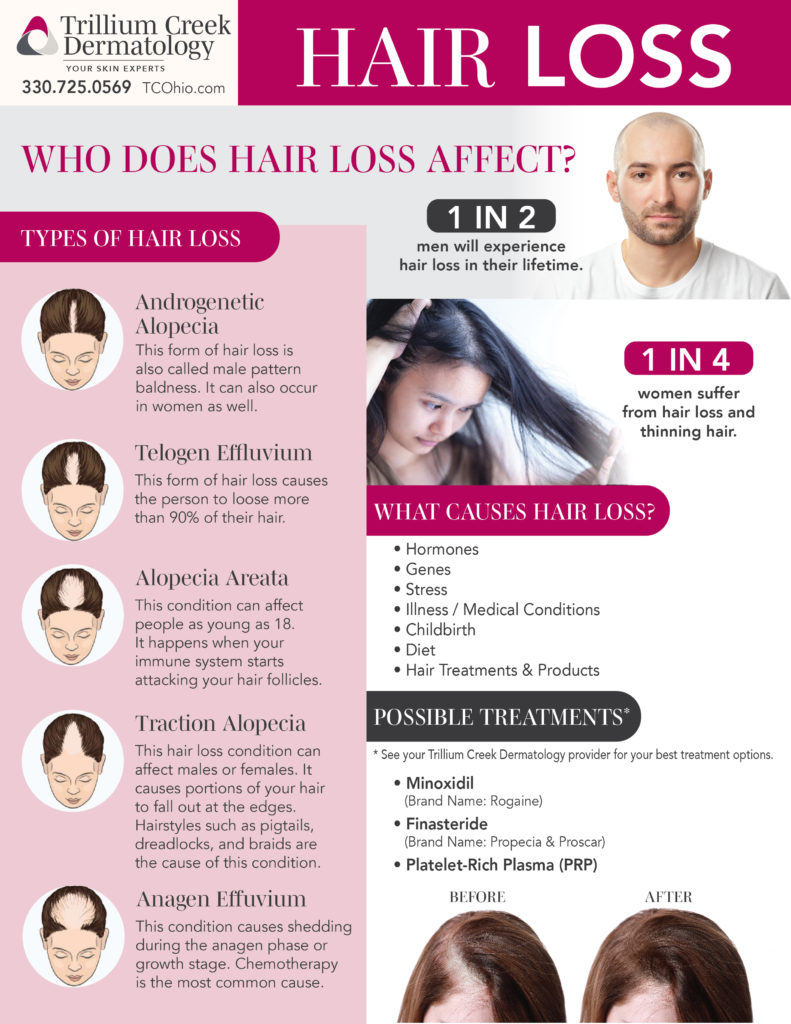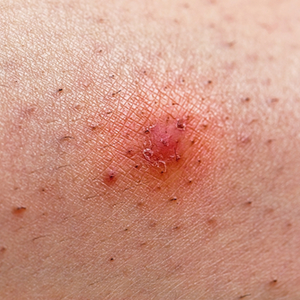Quick Links

Hair is susceptible to many of the conditions that affect skin, but it is also prone to a number of unique problems, including hair loss due to stress or an immune response in the body. Thick, healthy hair is a sign of good health and a boost to your confidence.
Hair loss not associated with aging or heredity (such as male pattern baldness) is generally called alopecia and can result from a stressor (such as childbirth, illness, etc.) or an immune response in the body. Hair may come out in large, well-defined clumps, or more gradually overall, and may affect all the hair on the body, including eyebrows and eyelashes. Hair loss is divided into two categories: non-scarring alopecias (hair may grow back since follicles are not lost) and scarring alopecia (hair follicles are permanently lost or damaged and hair can not grow back).
Alopecias
Non-Scarring Alopecias
Male and Female Pattern Baldness
Pattern hair loss has both genetic and hormonal causes. At least 80% of Caucasian men show evidence of hair loss by age 70. Male pattern hair loss is symmetrical and progressive, but the pattern of hair loss can vary among individuals.
Telogen Effluvium
A temporary period of hair loss in response to illness or stress.
Alopecia Areata
Round or oval patches of hair loss are caused by autoimmune disease, and can lead to total scalp or total body hair loss.
Scarring Alopecia
Traction Alopecia
Caused by tight hair styling, such as braids or curlers.
Central Centrifugal Cicatricial Alopecia
Chemical hair relaxers or ‘hot combs’ may aggravate this disease.
Lichen Planopilaris
Symptoms are inflammation, itching, and tenderness with hair loss.
Alopecia Treatment
Hair loss may be a symptom of another condition, so it is important to determine the cause. In most areas, hair regrows completely with no scarring or thinning. Your Trillium Creek Dermatology professionals have treatments available to encourage hair regrowth and reserve hair growth. We are serving the following communities and those surrounding: Wooster, Wadsworth, Medina, Brunswick, Strongsville, and Hinkley.
A topical formulation, Minoxidil, and an oral drug, Finasteride, have been approved by the US Food and Drug Administration for the treatment of male pattern baldness. Minoxidil is applied to the affected area twice a day. Other treatments are available to upon request.
The Trillium Creek Dermatology skin experts have the knowledge and experience you need to achieve a full, lustrous head of hair.

Razor Bumps and Ingrown Hairs

Razor bumps and ingrown hairs (Pseudofolliculitis Barbae) can result from close shaving in individuals with curly hair or with hair follicles oriented at an oblique angle to the skin surface. Closely shaved hairs re-enter the skin as they grow, causing lesions. The condition is seen most commonly in the neck, and if left untreated, can cause scarring and darkening of the skin.
Treatment for Razor Bumps and Ingrown Hairs
Your Trillium Creek Dermatology skin experts may draw upon a number of topical and oral antibiotics and anti-inflammatory preparations to treat the infection and reduce long-term damage to the skin. Shaving should be discontinued until the inflammation is under control. Alternatives to shaving may be recommended, including depilatories. Finally, permanent hair removal is available with Trillium Creek Dermatology’s Laser Hair Removal PPx™.



